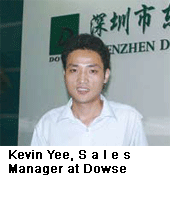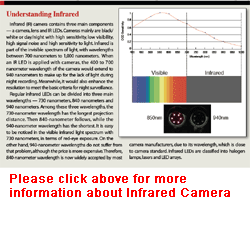Chinese IR camera players are located mostly in southern China, especially Shenzhen and the vicinity. ASMAG.com talks to major manufacturers, such as Borsche, CMU, Dowse, Jiaxinjie, Relong and Tiandy.
Chinese IR camera players are located mostly in southern China, especially Shenzhen and the vicinity. ASMAG.com talks to major manufacturers, such as Borsche, CMU, Dowse, Jiaxinjie, Relong and Tiandy.
Southern China plays an important role in the Chinese IR camera industry given its access to international technological and market hub Hong Kong. This makes it much easier for players in Shenzhen to purchase IR LEDs key components in IR cameras. This gives them an edge over their competitors in northern and eastern China.
"Also, demand for IR cameras is greater in southern China," said Kevin Yee, Sales Manager of Dowse. This means that players there have a competitive edge that facilitates development.
As IR cameras are mature, manufacturers are competing on the basis of refined  techniques and innovative functionality. Initially, Chinese IR camera players placed IR LEDs outside cameras to prevent heat damage; later, they launched embedded IR domes; now, many are providing advanced IR array solutions.
techniques and innovative functionality. Initially, Chinese IR camera players placed IR LEDs outside cameras to prevent heat damage; later, they launched embedded IR domes; now, many are providing advanced IR array solutions.
IR cameras trend to feature cold light, IR array light, laser night vision and IP. The advantage of cold light is on cost. Due to widespread use of arrayed IR LEDs, prices have fallen to levels that make the products only a little more expensive than standard products. IR array delivers longer life, no flashing, and no reflection from dust or human eyes. Now, it is used mostly by the military. In addition, laser night vision features no red-eye exposure and long-distance irradiation.
Key Components
Most Chinese IR camera players import lenses from Japan and IR LED chips from Taiwan.
"We choose 10 A LED chips from Tyntek (Taiwan) with pulse charge to facilitate heat dissipation even though they are 20 percent more expensive than domestic 12 A chips," said Zhang Wei, Product Manager of Tiandy. Tyntek LED chips  feature high power, low decay, long life (up to 20,000 hours) and equal radiation. To improve heat emission, the company's designs also incorporate constant current. CMU also uses Sanyo LED chips, besides Tyntek, that feature three times the illumination of common ones.
feature high power, low decay, long life (up to 20,000 hours) and equal radiation. To improve heat emission, the company's designs also incorporate constant current. CMU also uses Sanyo LED chips, besides Tyntek, that feature three times the illumination of common ones.
Meanwhile, Dowse is using Apex IR-cut filters. Moreover, the company purchases stepping motors, used to control IR-cut filter switch, from Japan as they are more precise. "Heat is going to be emitted no matter what," said Kevin
Yee, Sales Manager of Dowse. "Still, we can try to reduce the effects. We have placed IR LEDs outside the camera and the user can choose whether to link them to the camera."
When it comes to IR LED heat emissions, Borsche has decreased the current of its IC boards, adding a fan if interior space is available.
Besides resolution, water resistance capability is undoubtedly another primary consideration with IR cameras as they are mostly used outdoors where water-resistance is a must. "Our products all passed water-resistance of IP66, some even IP68," said Zhang.
Different irradiation distances are used in different applications. Long irradiation IR cameras are unnecessary indoors; rather they are used wherever there is a lot of grass as this absorbs a lot of IR light. Industry experts caution, however, that many IR camera manufacturers exaggerate irradiation figures so it is important to go with a company that has a good reputation.
Chinese companies may, however, face difficulties in the U.S. Recently, a retiring professor from Columbia University brought suit against 34 IR chip providers worldwide, including six Chinese companies, regarding alleged patent infringement.
According to the Chinese vendors interviewed, however, this will have little effect  on their operations. That said, manufacturers selling in the U.S. market may have to deal with higher material prices due to patent protection extended from the 337 investigation.
on their operations. That said, manufacturers selling in the U.S. market may have to deal with higher material prices due to patent protection extended from the 337 investigation.
Looking to Innovation
According to camera manufacturers, 70 percent of the cost of a Chinese camera comes from the Sony CCD chip. To be able to reduce its costs, Jiaxinjie invested in R&D.
"We are developing 22x optical and 16x digital all-in-one zoom cameras, which focus faster and offer a better cost-to-performance ratio than those from big international names," said David Wang, General Manager of Jiaxinjie. "We plan to launch them in Beijing at the end of this year." It also features excellent compatibility with speed dome, besides high-speed zoom the biggest challenge to Chinese camera players.
According to Wang, only by promoting the whole series of Jiaxinjie products can the company be competitive. This includes high-speed zoom and intelligent cameras. "Users can choose to focus on object faces, while adjusting sharpness, auto gain control and other settings. In addition, one remote controller is suitable for several cameras."
Relong owes its overseas success to unique designs and excellent night vision. "Our president," said Chatherine Ma, Export Director of Relong, "spends half a year visiting clients overseas to learn about their product requirements." To ensure good night vision, Relong tests each and every product. "We conduct IR irradiation distance testing at night," pointed out Ma.
Dowse's most special attribute is its IR-cut filter switch. "There are three types of IR-cut filter switches, namely switch by coil, lens and stepping motor," said Yee. "We were the first to use switch by stepping motor in China." Dowse IR cameras support external zoom adjustment for greater convenience.
 Overseas Performance
Overseas Performance
At Relong, overseas sales account for 50 percent of total revenue. Main overseas markets are Europe and the U.S. Every day, it ships 4,000 to 5,000 cameras. In order to meet the large number of orders, the company plans to set up two more production lines.
Borsche sells 95 percent of its product overseas, mostly in Europe. The company guarantees a delivery time of three days for orders of less than 500 cameras. "Our salesmen provide constant updates on shipment status," said Chen Zequn, General Manager of Borsche.
Aiming to sell to high-end markets in Europe and the U.S., CMU has buttressed its after-sales service. All products enjoy a three-year guarantee. The company also sends standby components for free (up to three percent of total order). Even though after-sales service may involve up to 10 percent of total costs, CMU has managed to keep its prices low.
Now, many Korean and Taiwanese clients buy Chinese boards for assembly with their shells, placing their logos on the outside. A lot of international buyers, however, know this and so they are skipping over these intermediaries to buy directly from trusted Chinese suppliers.